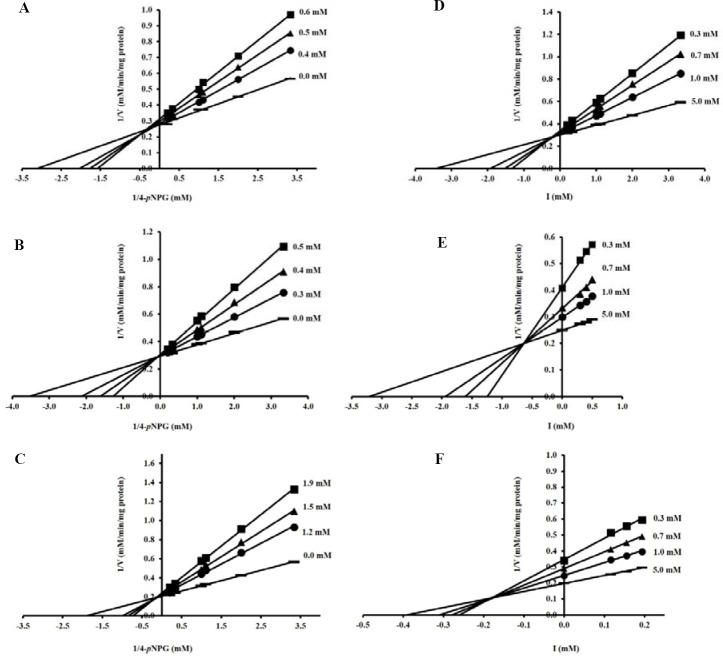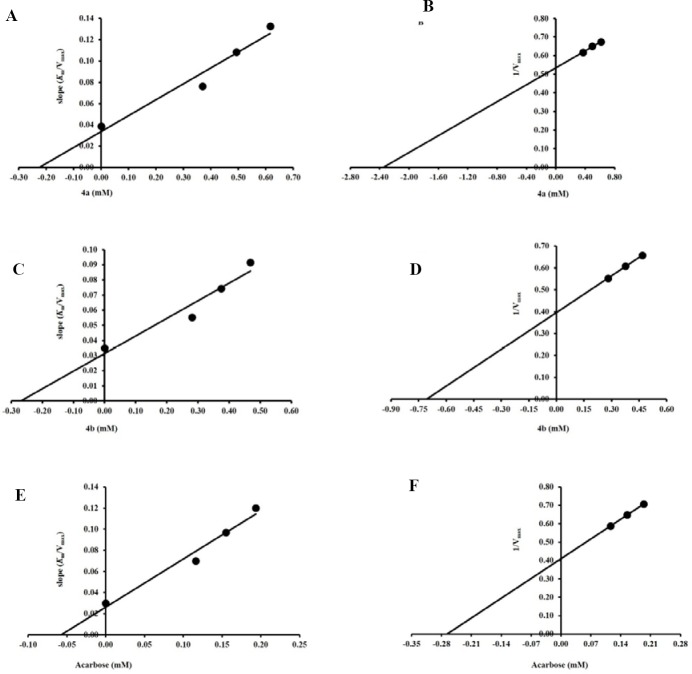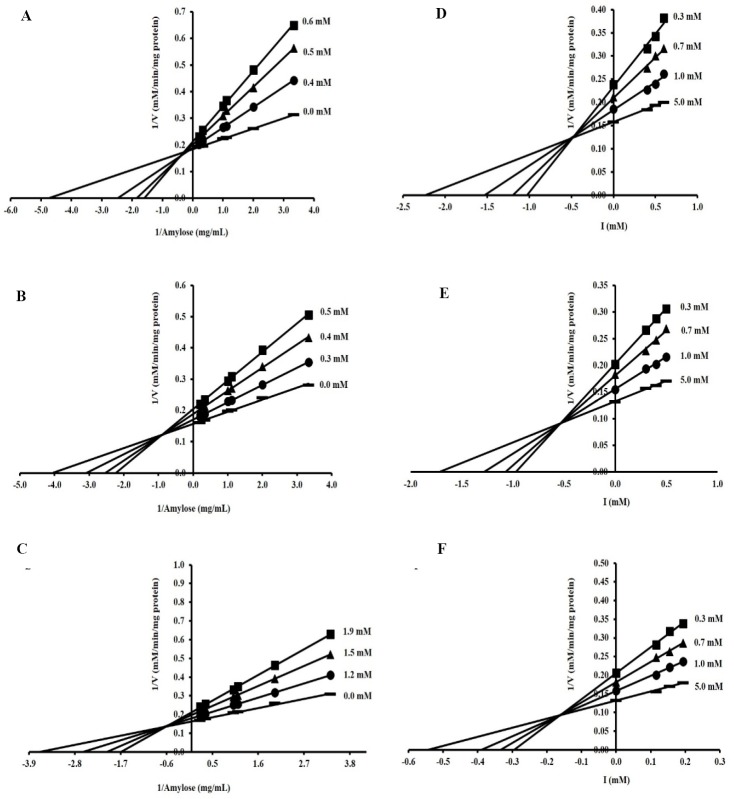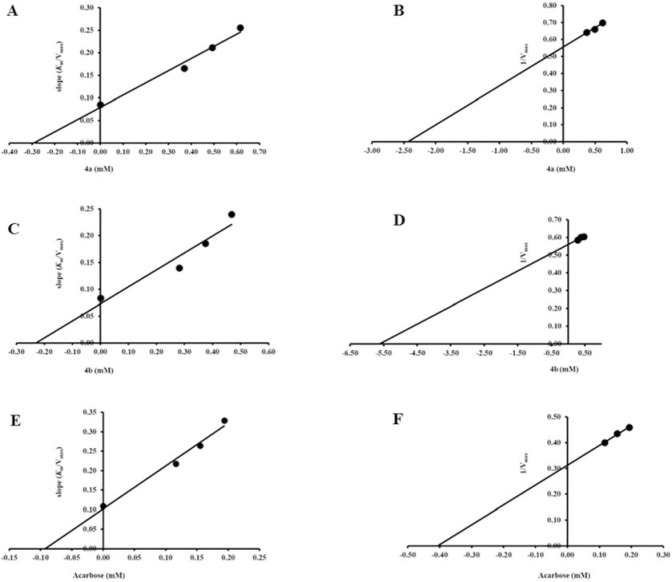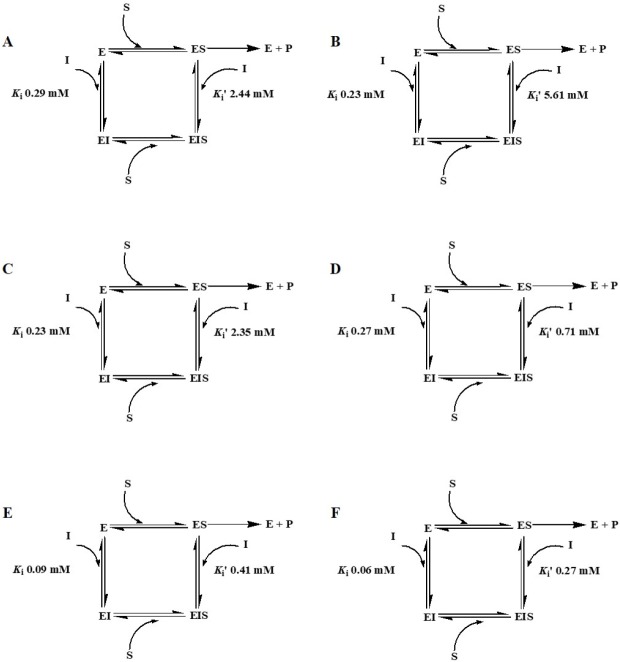Abstract
Background and purpose:
Carbohydrate hydrolysis enzymes including α-glucosidase and α-amylase are related to type 2 diabetes mellitus. The inhibiting of these enzymes might use for type 2 diabetes mellitus treatment.
Experimental approach:
N-substituted-acetylpyrrolidine linked with -benzyl- (N-(benzyl)-2-acetylpyrrolidine (4a)) and -tosyl- (N-(tosyl)-2-acetylpyrrolidine (4b)) were synthesized and evaluated for their pharmaceutical properties against α-glucosidase and α-amylase and free radical scavenging activity. The structures of 4a and 4b were determined through spectral studies (1H-NMR).
Findings / Results:
Both compounds 4a and 4b had highest inhibitory potential on α-glucosidase with the IC50 values of 0.52 ± 0.02 and 1.64 ± 0.08 mM, respectively. The kinetic investigation of 4a and 4b against α-glucosidase and α-amylase were functioned in mixed type inhibition. Moreover, both compounds are more likely to bind with the free enzyme than the enzyme-substrate complex based on the Ki < Ki´ on the α-glucosidase and α-amylase enzymes. Regarding the free radical scavenging, 4a had a higher capacity than 4b with IC50 values of 1.01 ± 0.010 mM for 4a and 1.82 ± 0.048 mM for 4b.
Conclusion and implications:
Our results indicated that a derivative of N-substitute-acetylpyrrolidine had high potential to inhibit α-glucosidase and α-amylase, and their free radical scavenging properties might be applied to the therapeutic care of patients with type 2 diabetes mellitus.
Keywords: α-Glucosidase and α-amylase inhibitory activity, Diabetes type 2, Type 2 diabetes mellitus, N-acetylpyrrolidine
INTRODUCTION
Diabetes mellitus is a chronic disorder related to a high blood glucose level (hyperglycemia) (1). The blood glucose level is controlled by the starch-hydrolyzing enzyme (2). The long chain of oligosaccharide undergoes hydrolysis by α-amylase to short chain carbohydrate and disaccharides, and finally, the glucose is released from disaccharides by α-glucosidase (3). Therefore, the inhibition of the starch-hydrolyzing enzyme might cause a reduction in the blood glucose level. Many researchers have reported the inhibitors of α-glucosidase and α-amylase, which is obtained from both natural inhibitors and synthetic inhibitors (4,5,6,7). Currently, diabetes is treated by inhibiting the starch-hydrolyzing enzyme with commercial inhibitors such as acarbose, miglitol, and voglibose (8,9,10). However, the use of commercial inhibitors for diabetes therapy involves many side effects, such as allergic reactions, diarrhea, and abnormal liver function (11,12). Thus the candidate of the new starch-hydrolyzing enzyme inhibitor without side effects from natural and synthetic sources might be important.
N-acetylpyrrolidine and its derivatives have been reported to function in biological activity and pharmaceutical activity. Strobilurin derivatives containing pyrrolidine-2,4-dione have shown fungicidal activity against Rhizoctonia solani, Botrytis cinerea, and Fusarium graminearum (13). A reduction in hyperglycemia after diabetes type 2 diabetes treatment by dipeptidyl peptidase IV (DPP-IV) which inhibits 1-[[(3-hydroxy-1-adamantyl) amino] acetyl]-2-cyano-(S)-pyrrolidine has been reported (14). Moreover, some more derivatives (oxopyrrolidine) have shown anti- Alzheimer’s properties by acting as acetyl cholinesterase inhibitors (15). Thus, the new candidate of N-acetylpyrrolidine derivatives might be important for pharmaceutical activity.
The benzyl group and its derivatives have also shown to have biological activity related to diabetes properties. One report showed that benzyl 2H-chromenones has α-amylase inhibitory properties and radical scavenging activities (16). Additionally, 5-[4-(1-methylcyclohexylmethoxy)benzyl]- thiazolidine-2,4-dione is effective to decrease hyperglycemia and improve insulin sensitivity in in vivo assays (17). The α-glucosidase inhibitory activity and free radical scavenging properties have been affected by benzyl-substituted flavones (18). In this study, we synthesized N-acetylpyrrolidine linked with -benzyl- and -tosyl- (Fig. 1) to investigate the new α-glucosidase and α-amylase inhibitor for further application in diabetes therapy.
Fig. 1.

Structure of (A) N-(benzyl)-2-acetylpyrrolidine (4a); (B) N-(tosyl)-2-acetylpyrrolidine (4b); and (C) acarbose.
MATERIAL AND METHODS
Material
All the chemicals and enzymes including acarbose, p-nitrophenyl-α-glucopyranoside (4-pNPG), amylose from potato, α-glucosidase from Saccharomyces cerevisiae, and α-amylase from Aspergillus oryzae, were obtained from Sigma-Aldrich (St. Louis, MO, USA).
General procedure for preparation of N-substituted-2-acetylpyrrolidine (4a-b)
Preparation of N-substituted-2- acetylpyrrolidine 4a-b was achieved according to the route shown in Scheme 1. N-substitution of pyrrolidine-2-carboxylic acid 1 (L-proline) was performed using benzyl chloride or tosyl chloride in basic condition followed by esterification with methanol via the transformation from acid chloride, which gave the N-(substituted)-2- (carbomethoxy) pyrrolidine 3a-b. N-(substituted)-2-acetylpyrrolidine 4a and 4b were produced by the Grignard reaction of compound 3a-b with methyl magnesium iodide.
Scheme 1.
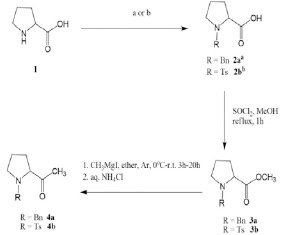
Preparation of N-substituted-2- acetylpyrrolidine (4a-b). DMF, N,N-dimethylformamide; a, 1. KOH, DMF, 0 oC, 10 min; 2. BnCl, r.t., 3 h; b, 1. 2M NaOH, 0 oC and 2. TsCl, 0 oC, 30 min, then 2M NaOH, room tempreture, 24 h.
N-benzylpyrrolidine-2-carboxylic acid (2a) (19)
Potassium hydroxide (0.63 g, 11 mmol) was added to a stirred solution of pyrrolidine- 2-carboxylic acid 1 (L-proline, 1.00 g, 8.6 mmol) in N,N-dimethylformamide (9.0 mL) at 0 °C. After 20 min under argon atmosphere, benzyl chloride (3 mL, 26 mmol) was added dropwise to a stirred solution at 0 °C. The reaction mixture was stirred at room temperature for 3 h. Then, the reaction mixture was poured into ice water and was extracted with diethyl ether (3 × 20 mL). The organic layers were combined, washed with brine solution, dried with anhydrous Na2SO4, and then concentrated under reduced pressure to give the crude product, which was purified by column chromatography (silica gel, Hexane:EtOAc, 4:1) to give N-benzyl pyrrolidine-2-carboxylic acid 2a as a pale yellow oil (0.60 g, 34% yield); proton nuclear magnetic resonance (1H-NMR) (CDCl3) {lit. (20)}: δ 1.70-2.20 (m, 3H), 2.35-2.50 (m, 1H), 3.05 (dd, J = 18.9, 9.0 Hz, 1H), 3.32 (dd, J = 18.9, 9.0 Hz, 1H), 3.55-4.00 (dd, J = 108, 24 Hz, 1H), 5.10 (sd, J = 3 Hz, 2H), 7.20-7.40 (m, 5H, Ar).
N-tosylpyrrolidine-2-carboxylic acid (2b) (21)
Pyrrolidine-2-carboxylic acid 1 (L-proline, 1.00 g, 8.6 mmol) was dissolved in aqueous 2.0 M NaOH (8.6 mL) at 0 °C. The p-toluenesulfonyl chloride (1.60 g, 8.4 mmol) was added to a stirred solution. After 30 min; the aqueous 2.0 M NaOH (0.5 mL) was added to a stirred solution. After 24 h, the solution was washed with diethyl ether (2 × 100 mL) the aqueous layers were combined with aqueous 2.0M NaOH (20 mL) and acidified to pH 1.0 with concentrated HCl. The aqueous layer was extracted with ethyl acetate (3 × 30 mL) and the organic layers were combined, washed with brine, dried with anhydrous Na2SO4, and then concentrated under reduced pressure to produce N-tosyl pyrrolidine-2-carboxylic acid 2b as a pale yellow oil (2.14 g, 94% yield);1H-NMR (CDCl3){lit. (22)}:δ = 1.932.14 (m, 4 H), 2.44 (s, 3 H), 3.23-3.29 (m, 1 H), 3.49-3.55 (m, 1 H), 4.18-4.28 (dd, J = 8.4, 4.4 Hz, 1 H), 7.33-7.35 (d, J = 8.4 Hz, 2H), 7.76-7.78 ppm (d, J = 8.0 Hz, 2H), 8.15 ppm (brs, 1H, OH).
General procedure for the preparation of N-(substituted)-2-(carbomethoxy) pyrrolidine (3a-b) (23)
A solution of N-(substituted) pyrrolidine-2- carboxylic acid (30 mmol) in dry methanol (30 mL) was cooled to 0 °C. The SOCl2 (33 mmol) was added dropwise to the reaction mixture. The solution was stirred for 1 h under refluxing conditions and then allowed to cool to room temperature. The solvent was removed in vacuo, producing N-(substituted)-2-(carbomethoxy) pyrrolidine.
N-(benzyl)-2-(carbomethoxy) pyrrolidine (3a)
The following general procedure was employed: treatment of N-benzyl pyrrolidine- 2-carboxylic acid 2a (0.56 g, 2.7 mmol) with SOCl2 (0.3 mL, 4.1 mmol) in dry methanol (3 mL) gave the N-(benzyl)-2- (carbomethoxy)pyrrolidine 3a as a white solid (0.52 g, 88% yield); NMR (CDCl3){lit. (24)}: δ 1.70-2.20 (m, 3 H), 2.35-2.45 (m, 1H), 3.03 (dd, J = 8.5, 6.2 Hz. 1 H), 3.24 (dd, J = 8.6, 6.3 Hz, 1H), 3.57-3.98 (dd, J = 117, 24 Hz, 1H), 3.64 (s, 3 H), 5.10 (sd, J = 3 Hz, 2H), 7.20-7.45 (m, 5 H).
N-(tosyl)-2-(carbomethoxy) pyrrolidine (3b)
The following general procedure was employed: treatment of N-tosyl pyrrolidine-2- carboxylic acid 2b (0.50 g, 1.8 mmol) with SOCl2 (0.4 mL, 4.9 mmol) in dry methanol (2 mL). Then, the reaction mixture was concentrated under reduced pressure and the residue was stored in an ice chest overnight. Then, the residue was poured into an aqueous solution of potassium carbonate (50% w/v, 3.0 mL) at 0 °C, which produced N-(tosyl)-2-(carbomethoxy) pyrrolidine 3b as a yellow oil (0.36 g, 71% yield); NMR (CDCl3){lit. (25)}: δ 1.70-1.85 (m, 1H), 1.90-2.10 (m, 3H), 2.43 (s, 3H), 3.30 (ddd, J = 4.5, 7.1, 9.5 Hz, 1H), 3.50 (ddd, J = 4.7, 7.2, 9.8 Hz, 1H), 3.75 (s, 3H), 4.32 (dd, J = 4.6, 8.0 Hz, 1H), 7.32 (d, J = 8.2 Hz, 2H), 7.80 (d, J = 8.2 Hz, 2H).
General procedure for the preparation of N-(substituted)-2-acetylpyrrolidine (4a-b) (26)
The Grignard reagent was prepared from magnesium turnings (120 mmol) and methyl iodide (120 mmol) in dry ether (120 mL) under reflux with an argon atmosphere for 1 h. The solution of N-(substituted)-2- (carbomethoxy) pyrrolidine (40 mmol) in dry ether (20 mL) was cooled in an ice bath, which was added to freshly prepared methyl magnesium iodide at 0 °C and stirred continuously at 0 °C to room temperature for 20 h. The supernatant was cautiously poured into a stirred ice-cold aqueous ammonium chloride solution. The viscous residue remaining in the reaction flask was triturated with the ice-cold mixture. The clear organic and aqueous layers were vigorously stirred for 20 min at ambient temperature. The organic layer was isolated, and the aqueous phase was extracted with ether (2 × 20 mL). The ether extracts were combined and dried with anhydrous Na2SO4. The drying agent was filtered, and the solvent was removed in vacuo without heating to produce N-(substituted)-2-acetylpyrrolidine.
N-(benzyl)-2-acetylpyrrolidine (4a)
The following general procedure was employed: treatment of N-(benzyl)-2- (carbomethoxy) pyrrolidine 3a (0.36 g, 1.6 mmol) with freshly prepared methyl magnesium iodide to give N-(benzyl)- 2-acetylpyrrolidine 4a as a pale yellow oil (0.29 g, 91% yield); NMR (CDCl3){lit. (27)}: 1.29 (s, 3H), 1.70-2.00 (m, 3H), 2.32-2.49 (m, 1H), 3.03 (dd, J = 8.3, 12.0 Hz, 1H), 3.31 (dd, J = 8.3, 12.1 Hz, 1H), 3.51-3.98 (dd, J = 108, 15 Hz, 1H), 5.10 (sd, J = 3 Hz, 2H), 7.15-7.41 (m, 5H).
N-(tosyl)-2-acetylpyrrolidine (4b)
The following general procedure was employed: treatment of N-(tosyl)-2- (carbomethoxy) pyrrolidine (3b) (0.10 g, 0.35 mmol) with freshly prepared methyl magnesium iodide to give N-(tosyl)-2- acetylpyrrolidine (4b) as a pale yellow oil (0.083 g, 88% yield); NMR (CDCl3){lit. (28)}: 0.90-1.74 (m, 4H), 1.25 (s, 3H), 2.40 (s, 3H), 3.10-3.28 (m, 1H), 3.50-3.62 (m, 2H), 7.25 (d, J = 9.2 Hz, 2H), 7.68 (d, J = 9.2 Hz, 2H).
α-Glucosidase assay
The α-glucosidase inhibitory properties of each compound were measured using a spectrophotometric method with some modification of a procedure described in a previous study (7). The samples (4a and 4b) were prepared in 50 mM sodium phosphate buffer, pH 6.8. In the 100 μL mixture reaction, 10 μL of different concentrations of samples (final concentration of 0.04 to 8.00 mM), 5 μL of 0.25 mM 4-pNPG, and 5 μL of 0.05 mg/mL α-glucosidase were included. The reaction was incubated at 37 °C for 30 min. Then, the enzyme activity was stopped with 100 μL of 0.5 M Na2CO3. The release of the p-nitrophenolate group was monitored with a spectrophotometer at 405 nm. The inhibitory activity of each compound on α-glucosidase was calculated from the concentration that inhibited 50% of the enzyme activity (IC50). Acarbose was used as the standard inhibitor. The percentage of inhibition of samples and acarbose on α-glucosidase was calculated using equation below. The IC50 values of the samples and acarbose were calculated using the Grafit 5.0 computer program (Erithacus Software, Horley, UK).

where, A is the activity of the enzyme without the sample solution and B is the activity of the enzyme with the sample solution.
α-Amylase assay
The α-amylase activity was determined using a modification of previous methods (29). The reaction was mixed with 10 μL of different concentrations of samples (final concentration of 0.05 to 11.00 mM), 10 μL of 0.05 mg/mL amylose, and 10 μL of 0.05 mg/mL of α-amylase in 20 mM sodium phosphate buffer, pH 6.8. This mixed solution was incubated at 37 °C for 30 min and then the reaction was stopped in boiling water for 5 min. The amount of glucose was determined with a peroxidase-glucose oxidase assay. The reaction was terminated by adding 100 μL of couple enzyme (peroxidase-glucose oxidase enzyme) and 100 μL of 2,2’-azino-bis-3- ethylbenzthiazoline-6-sulphonic acid and then further incubated at 37 °C for 30 min. The absorbance was monitored using spectrophotometry at 475 nm. The α-amylase inhibition was calculated as percentage inhibition using aforementioned equatione. IC50 values were calculated in the same way as for α-glucosidase.
Kinetic study
The kinetic analysis (inhibition type) of each enzyme was determined from Lineweaver-Burk and Dixon plots. The inhibition constants (Ki and Ki´) were determined from slope (from Linweaver-Burk plot) vs I for Ki and 1/Vmax vs I for Ki´. The inhibition type of each enzyme was maintained at the same concentration as the reaction above, while the concentrations of 4a and 4b were 0.30 to 0.60 mM. The 4-pNPG and amylose were used as substrates for α-glucosidase and α-amylase, respectively, and acarbose was used as the standard inhibitor.
DPPH assay
The antioxidant activity was determined using a modification of a method used in a previous study (30). The samples (4a and 4b) were dissolved in MeOH and then added to 1 mM DPPH solution (100 μL) to give the final concentration of 0.04 to 11.00 mM. The reaction mixture was incubated at room temperature under dark conditions. The absorbance of the final product was measured at 517 nm with a UV/Vis spectrophotometer (AOE Instruments, Shanghai, China).
Statistical analysis
The inhibition percentage and IC50 data were expressed as standard division of mean (means ± SD). One-way analysis of variance (ANOVA) was used to investigate the statistical significance. A P value less than 0.05 was considered statistically significant.
RESULTS
Chemistry
The N-substituted-2-acetylpyrrolidine 4a and 4b samples were prepared from commercial pyrrolidine-2-carboxylic acid 1 (L-proline), which was used as the starting material. The preparation was started from the preparation of N-substituted pyrrolidine-2- carboxylic acid 2a-b. The pyrrolidine-2- carboxylic acid 1 underwent protection of the amino group with benzyl chloride (19) and p-toluene sulfonyl chloride (21) under basic conditions, providing N-benzylpyrrolidine-2-carboxylic acid 2a at 34% w/w yield after purification by column chromatography and N-tosylpyrrolidine-2- carboxylic acid 2b at 94% w/w yield. The N-substituted pyrrolidine-2-carboxylic acid 2a-b then underwent one-pot esterification using a procedure via conversion of the carboxyl group to acid chloride by refluxing with thionyl chloride in dry methanol, affording N-(substituted)-2- (carbomethoxy) pyrrolidine 3a-b at an excellent yield (23). Following the Grignard protocol (26), reaction of N-substituted pyrrolidine-2-carboxylic acid 2a-b with methyl magnesium iodide in ether at 0 °C to room temperature led to the transformation of methyl ester moiety to methyl ketone, which provided the N-substituted-2-acetylpyrrolidine 4a-b at an excellent yield without purification. The structures of these synthesized compounds were characterized by their 1H-NMR spectral data according to a previous study.
Enzyme inhibition and antioxidant activity of 4a and 4b
The inhibitory potential of 4a and 4b with the inhibition percentage and IC50 values are shown in Table 1. Samples 4a and 4b were presented to inhibit α-glucosidase and α-amylase with inhibition percentages of 40.27 ± 0.80 and 32.31 ± 0.29 for α-glucosidase and 28.93 ± 0.57 and 30.11 ± 0.78 for α-amylase. The IC50 values of both samples against α-glucosidase and α-amylase were showed of 0.52 ± 0.02 mM and 1.64 ± 0.08 mM for α-glucosidase and 2.72 ± 0.09 mM and 3.21 ± 0.65 mM for α-amylase. The inhibition type and constant (Ki and Ki´) of 4a and 4b on α-glucosidase and α-amylase are shown in Table 2 and Figs. 2-5. The inhibition type of both samples were presented in mixed type inhibition which the same as standard inhibitor acarbose.
Table 1.
Inhibitory potential of 4a and 4b on α-glucosidase and α-amylase. Values represent the mean ± SD, n = 3
| Samples | Inhibition at 0.02 mM (%) | IC50 values (mM) | ||
|---|---|---|---|---|
| α-Glucosidase | α-Amylase | α-Glucosidase | α-Amylase | |
| 4a | 40.27 ± 0.80b | 28.93 ± 0.57b | 0.52 ± 0.02b | 3.21 ± 0.65a |
| 4b | 32.31 ± 0.29c | 30.11 ± 0.78b | 1.64 ± 0.08a | 2.72 ± 0.09a |
| Acarbose | 71.34 ± 1.10a | 61.68 ± 1.14a | 0.16 ± 0.01c | 0.22 ± 0.002b |
The different superscript letters indicating significant difference among mean values within a same column (P < 0.05).
Table 2.
Kinetic parameters of 4a and 4b.
| Samples | α-Glucosidase | α-Amylase | ||||
|---|---|---|---|---|---|---|
| Ki (mM) | Ki´ (mM) | Type | Ki (mM) | Ki´ (mM) | Type | |
| 4a | 0.29 | 2.44 | Mixed type | 0.23 | 2.35 | Mixed type |
| 4b | 0.23 | 5.61 | Mixed type | 0.27 | 0.71 | Mixed type |
| Acarbose | 0.09 | 0.41 | Mixed type | 0.06 | 0.27 | Mixed type |
Fig. 2.
Lineweaver-Burk plot of (A) 4a, (B) 4b, (C) acarbose; and Dixon plots of (D) 4a, (E) 4b, and (F) acarbose for α-glucosidase inhibitory activity.
Fig. 5.
Secondary plot of slope (Km/Vmax) vs [I] for determination of K and secondary plot of 1/Vmax vs [I] for determination of K¡´ of (A and B) 4a, (C and D) 4b, and (E and F) acarbose for α-amylase inhibitory activity.
The antioxidant potentials of 4a and 4b are shown in Table 3. The results reveal that the IC50 values were low for compound 4a (1.01 ± 0.010 mM) and high for compound 4b (1.82 ± 0.048 mM), indicating that the antioxidant capacity among the compounds is significantly higher (P < 0.05) in compound 4a.
Table 3.
Antioxidant potential of 4a and 4b. Values represent the mean ± SD, n = 3 .
| Samples | Inhibitory activity at 0.5 mM (%) | IC50) mM ( |
|---|---|---|
| 4a | 41.62 ± 0.64a | 1.01 ± 0.010b |
| 4b | 34.28 ± 0.73b | 1.82 ± 0.048a |
The different superscript letters indicating significant difference among mean values within a same column (P < 0.05).
DISCUSSION
Based on the inhibition percentage, the inhibition activity of 4a and 4b on α-glucosidase had higher potential than α-amylase. However, the inhibition percentages of both 4a and 4b were lower than the standard inhibitor acarbose by approximately 2.21 times on α-glucosidase and 2.13 times on α-amylase. Based on the IC50 values of these compounds, the inhibitory activity on α-glucosidase and α-amylase was consistent with the inhibition percentage. 4a had the highest inhibitory effect on α- glucosidase inhibitory activity with IC50 values of 0.52 ± 0.02 mM, whereas 4b, with IC50 values of 1.64 ± 0.08 mM, had also higher potential on α-glucosidase inhibitory activity than α-amylase inhibitory activity but still less potential than 4a on α-glucosidase inhibitory activity. The lowest inhibitory activity was obtained from 4a on α-amylase inhibitory activity with IC50 values of 3.21 ± 0.65 mM and approximately 1.20 times less potential than 4b on α-amylase inhibitory activity and less potential than 4b and 4a on α-glucosidase inhibitory activity by approximately 2.0 times and 6.2 times, respectively. A previous researcher also reported the inhibitory potential of compound 9a/b (N-benzyl-benzimidazolyl) on α-glucosidase and α-amylase. The compound 9b with a chloro substitution at position 4 of the N-benzyl ring had higher potential on α-glucosidase than compound 9a without chloro substitution (6). Our results also showed the high potential of compound 4a (N-(benzyl)-2-acetylpyrrolidine) on α-glucosidase, which is consistent with previous reports.
The Lineweaver-Burk plots suggest that 4a worked against both α-glucosidase (from Saccharomyces cerevisiae) and α-amylase (from Aspergillus oryzae) functions in mixed type inhibition. The 4b compound against α-glucosidase and α-amylase was also shown in mixed type inhibition. The inhibition type of the standard inhibitor acarbose that retarded both α-glucosidase and α-amylase was also determined to be mixed type inhibition (Figs. 2 and 3). As shown in Figs. 4-6, the Ki and Ki´of 4a were 0.29 and 2.44 mM for α-glucosidase and 0.23 and 2.35 mM for α-amylase, which indicates that it is more likely to bind with a free enzyme than the enzyme-substrate complex. The Ki values of 4a on α-glucosidase and α-amylase showed little difference, and the results indicated that it is suitable to bind for the active site of α-amylase. Base on the Ki and Ki´ values of 4b, the results showed that it also more likely to bind with a free enzyme than the enzyme-ubstrate complex. The Ki and Ki´of 4b were 0.23 and 5.61 mM for α-glucosidase and 0.27 and 0.71 mM for α-amylase, respectively. Moreover, the binding efficiency of 4b with α-glucosidase was shown to be higher than with α-amylase. A previous study showed that the inhibitory activity of the benzyl group has a function in non-competitive inhibition on α-glucosidase with a Ki of 18 mM toward maltose (30). Another study showed the α-glucosidase inhibitory activity of N-benzyl derivative in a rat model (31). Our results and previous reports suggest that the compounds linked with -benzyl- and -tosyl- have potential inhibitory activity on α-glucosidase and α-amylase.
Fig. 3.
Lineweaver-Burk plot of (A) 4a, (B) 4b, (C) acarbose; and Dixon plots of (D) 4a, (E) 4b, and (F) acarbose for α-amylase inhibitory activity.
Fig. 4.
Secondary plot of slope (Km/Vmax) vs [I] for determination of Ki and secondary plot of 1/Vmax vs [I] for determination of Ki´ of (A and B) 4a, (C and D) 4b, and (E and F) acarbose for α-glucosidase inhibitory activity.
Fig. 6.
Proposed inhibitory mechanism of (A and B) 4a and 4b against α-glucosidase, (C and D) 4a and 4b against α-amylase, and (E and F) acarbose against α-glucosidase and α-amylase. E, Enzyme; S, substrate; P, product; I, inhibitor; ES, enzyme-substrate complex; EI, enzyme-inhibitor complex; ESI, enzyme-substrate-inhibitor complex.
CONCLUSION
N-acetylpyrrolidine substitute with -benzyl- (4a) and -tosyl- (4b) was synthesized and investigated for inhibitory activity against diabetes type 2 diabetes α-glucosidase and α- amylase and free radical scavenging. The inhibition percentages values revealed that 4a and 4b showed the highest potential inhibitory activity on α-glucosidase with IC50 values of 0.52 ± 0.02 and 1.64 ± 0.08 mM, respectively. The kinetic analysis suggests that 4a and 4b against α-glucosidase and α-amylase function in mixed type inhibition. The DPPH assays of both compounds showed that 4a had higher potential for free radical scavenging compared to 4b.
CONFLICT OF INTEREST STATEMENT
The authors declare that there is no conflict of interest.
AUTHORS’ CONTRIBUTION
The experiment and data analysis were provided by S. Sansenya, K. NaNok, C. Winyakul, and W. S. Phutdhawong. English language was checked by S. Sansenya. The manuscript was written by S. Sansenya.
ACKNOWLEDGMENTS
This work was financially supported by the National Research Council of Thailand under the Grant No. 256200012103, Rajamangala University of Technology Thanyaburi and Silpakorn University.
REFERENCES
- 1.Emerging Risk Factors Collaboration. Sarwar N, Gao P, Seshasai SR, Gobin R, Kaptoge S, et al. Diabetes mellitus, fasting blood glucose concentration, and risk of vascular disease: a collaborative meta-analysis of 102 prospective studies. Lancet. 2010;375(3):2215–2222. doi: 10.1016/S0140-6736(10)60484-9. [DOI] [PMC free article] [PubMed] [Google Scholar]
- 2.Guo X, Li H, Xu H, Woo S, Dong H, Lu F, et al. Glycolysis in the control of blood glucose homeostasis. Acta Pharm Sin B. 2012;2(4):358–367. [Google Scholar]
- 3.Butterworth PJ, Warren FJ, Ellis PR. Human α- amylase and starch digestion: an interesting marriage. Starch-Starke. 2011;63(7):395–405. [Google Scholar]
- 4.Lestari W, Dewi RT, Kardono LBS, Yanuar A. Docking sulochrin and its derivative as α-glucosidase inhibitors of Saccharomyces cerevisiae. Indones J Chem. 2017;17(1):144–150. [Google Scholar]
- 5.Zhang BW, Xing Y, Wen C, Yu XX, Sun WL, Xiu ZL, et al. Pentacyclic triterpenes as α-glucosidase and α-amylase inhibitors: structure-activity relationships and the synergism with acarbose. Bioorg Med Chem Lett. 2017;27(2):5065–5070. doi: 10.1016/j.bmcl.2017.09.027. [DOI] [PubMed] [Google Scholar]
- 6.Singh G, Singh A, Verma RK, Mall R, Azeem U. Synthesis, biological evaluation and molecular docking studies of novel benzimidazole derivatives. Comput Biol Chem. 2018;72:45–52. doi: 10.1016/j.compbiolchem.2017.12.010. [DOI] [PubMed] [Google Scholar]
- 7.Sari S, Barut B, Özel A, Kuruüzüm-Uz A, Şöhretoğlu D. Tyrosinase and α-glucosidase inhibitory potential of compounds isolated from Quercus coccifera bark: in vitro and in silico perspectives. Bioorg Chem. 2019;86:296–304. doi: 10.1016/j.bioorg.2019.02.015. [DOI] [PubMed] [Google Scholar]
- 8.Yoshikawa M, Murakami T, Yashiro K, Matsuda H. Kotalanol, a potent alphα-glucosidase inhibitor with thiosugar sulfonium sulfate structure, from antidiabetic ayurvedic medicine Salacia reticulata. Chem Pharm Bull (Tokyo) 1998;46(8):1339–1340. doi: 10.1248/cpb.46.1339. [DOI] [PubMed] [Google Scholar]
- 9.Van de Laar FA. Alphα-glucosidase inhibitors in the early treatment of type 2 diabetes. Vasc Health Risk Manag. 2008;4(6):1189–1195. doi: 10.2147/vhrm.s3119. [DOI] [PMC free article] [PubMed] [Google Scholar]
- 10.Yilmazer-Musa M, Griffith AM, Michels AJ, Schneider E, Frei B. Grape seed and tea extracts and catechin 3-gallates are potent inhibitors of α-amylase and α-glucosidase activity. J Agric Food Chem. 2012;60(6):8924–8929. doi: 10.1021/jf301147n. [DOI] [PMC free article] [PubMed] [Google Scholar]
- 11.Gupta P, Bala M, Gupta S, Dua A, Dabur R, Injeti E, et al. Efficacy and risk profile of anti-diabetic therapies: conventional vs traditional drugs-A mechanistic revisit to understand their mode of action. Pharmacol Res. 2016;113(Pt A):636–674. doi: 10.1016/j.phrs.2016.09.029. [DOI] [PubMed] [Google Scholar]
- 12.Dhameja M, Gupta P. Synthetic heterocyclic candidates as promising α-glucosidase inhibitors: an overview. Eur J Med Chem. 2019;176:343–377. doi: 10.1016/j.ejmech.2019.04.025. [DOI] [PubMed] [Google Scholar]
- 13.Lu GH, Chu HB, Chen M, Yang CL. Synthesis and bioactivity of novel strobilurin derivatives containing the pyrrolidine-2, 4-dione moiety. Chinese Chem Lett. 2014;25(1):61–64. [Google Scholar]
- 14.Villhauer EB, Brinkman JA, Naderi GB, Burkey BF, Dunning BE, Prasad K, et al. 1-[[(3-hydroxy-1- adamantyl) amino] acetyl]-2-cyano-(S)-pyrrolidine: a potent, selective, and orally bioavailable dipeptidyl peptidase IV inhibitor with antihyperglycemic properties. J Med Chem. 2003;46(3):2774–2789. doi: 10.1021/jm030091l. [DOI] [PubMed] [Google Scholar]
- 15.Mohamed LW, Abuel-Maaty SM, Mohammed WA, Galal MA. Synthesis and biological evaluation of new oxopyrrolidine derivatives as inhibitors of acetyl cholinesterase and β amyloid protein as anti-Alzheimer’s agents. Bioorg Chem. 2018;76:210–217. doi: 10.1016/j.bioorg.2017.11.008. [DOI] [PubMed] [Google Scholar]
- 16.Kumar JA, Tiwari AK, Saidachary G, Kumar DA, Ali Z, Sridhar B, et al. New convenient approach for the synthesis of benzyl 2H-chromenones and their α-amylase inhibitory, ABTS+ scavenging activities. Med Chem. 2013;9(6):806–811. doi: 10.2174/1573406411309060004. [DOI] [PubMed] [Google Scholar]
- 17.Fujita T, Sugiyama Y, Taketomi S, Sohda T, Kawamatsu Y, Iwatsuka H, et al. Reduction of insulin resistance in obese and/or diabetic animals by 5-[4-(1-methylcyclohexylmethoxy) benzyl]- thiazolidine-2, 4-dione (ADD-3878, U-63,287, ciglitazone), a new antidiabetic agent. Diabetes. 1983;32(9):804–810. doi: 10.2337/diab.32.9.804. [DOI] [PubMed] [Google Scholar]
- 18.Kumar GS, Tiwari AK, Rao VR, Prasad KR, Ali AZ, Babu KS. Synthesis and biological evaluation of novel benzyl-substituted flavones as free radical (DPPH) scavengers and α-glucosidase inhibitors. J Asian Nat Prod Res. 2010;12(1):978–984. doi: 10.1080/10286020.2010.511190. [DOI] [PubMed] [Google Scholar]
- 19.Phutdhawong W, Winyakul C, Phutdhawong WS. Synthesis of 3-indolylacetamide derivatives and evaluation of their plant growth regulator activity. Maejo Int J Sci Tech. 2014;8(2):181–189. [Google Scholar]
- 20.Tang YQ, Lu JM, Wang XR, Shao LX. Palladium(II)-N-heterocyclic carbene complexes derived from proline: synthesis and characterization. Tetrahedron. 2010;66(0):7970–7974. [Google Scholar]
- 21.Berry MB, Craig D. A convenient method for the preparation of enantiomerically pure 2-substituted N-tosylaziridines. Synlett. 1992;1:41–44. [Google Scholar]
- 22.Han ZJ, Wang R, Zhou YF, Liu L. Simple derivatives of natural amino acids as chiral ligands in the catalytic asymmetric addition of phenylacetylene to aldehydes. Eur J Org Chem. 2005;2005(5):934–938. [Google Scholar]
- 23.Yeh MCP, Chen HF, Huang YY, Weng YT. Diastereoselective synthesis of fluorine-containing pyrrolizidines via triphenylcarbenium tetrafluoroborate-promoted carbofluorination of N-3-arylpropargylpyrrolidine-tethered tertiary allylic alcohols. J Org Chem. 2015;80(1):10892–10903. doi: 10.1021/acs.joc.5b02025. [DOI] [PubMed] [Google Scholar]
- 24.Corey EJ, Link JO. A catalytic enantioselective synthesis of denopamine, a useful drug for congestive heart failure. J Org Chem. 1991;56(1):442–444. [Google Scholar]
- 25.Paz NR, Rodríguez-Sosa D, Valdés H, Marticorena R, Melián D, Copano MB, et al. Chemoselective intramolecular functionalization of methyl groups in nonconstrained molecules promoted by N-iodosulfonamides. Org Lett. 2015;17(0):2370–2373. doi: 10.1021/acs.orglett.5b00866. [DOI] [PubMed] [Google Scholar]
- 26.De Kimpe NG, Stevens CV, Keppens MA. Synthesis of 2-acetyl-1-pyrroline, the principal rice flavor component. J Agric Food Chem. 1993;41:1458–1461. [Google Scholar]
- 27.Zhao S, Jeon HB, Nadkarni DV, Sayre LM. Acid-catalyzed rearrangement of 1-benzyl-2-methyl- 3-piperidone to 1-benzyl-2-acetylpyrrolidine. Tetrahedron. 2006;62(6):6361–6369. [Google Scholar]
- 28.Evans DA, Nelson JV, Vogel E, Taber TR. Stereoselective aldol condensations via boron enolates. J Am Chem Soc. 1981;103(1):3099–3111. [Google Scholar]
- 29.Kazeem MI, Adamson JO, Ogunwande IA. Modes of inhibition of α-amylase and α-glucosidase by aqueous extract of Morinda lucida Benth leaf. Biomed Res Int. 2013;2013:1–6. doi: 10.1155/2013/527570. [DOI] [PMC free article] [PubMed] [Google Scholar]
- 30.Pavlovic M, Dimitrijevic A, Bezbradica D, Milosavic N, Gavrovic-Jankulovic M, Šegan D, et al. Dual effect of benzyl alcohol on α-glucosidase activity: efficient substrate for high yield transglucosylation and non-competitive inhibitor of its hydrolytic activity. Carbohydr Res. 2014;387:14–18. doi: 10.1016/j.carres.2013.08.028. [DOI] [PubMed] [Google Scholar]
- 31.Faber ED, van den Broek LA, Oosterhuis EE, Stok BP, Meijer DK. The N-benzyl derivative of the glucosidase inhibitor 1-deoxynojirimycin shows a prolonged half-life and a more complete oral absorption in the rat compared with the N- methyl analog. Drug Deliv. 1998;5(1):3–12. doi: 10.3109/10717549809052021. [DOI] [PubMed] [Google Scholar]



